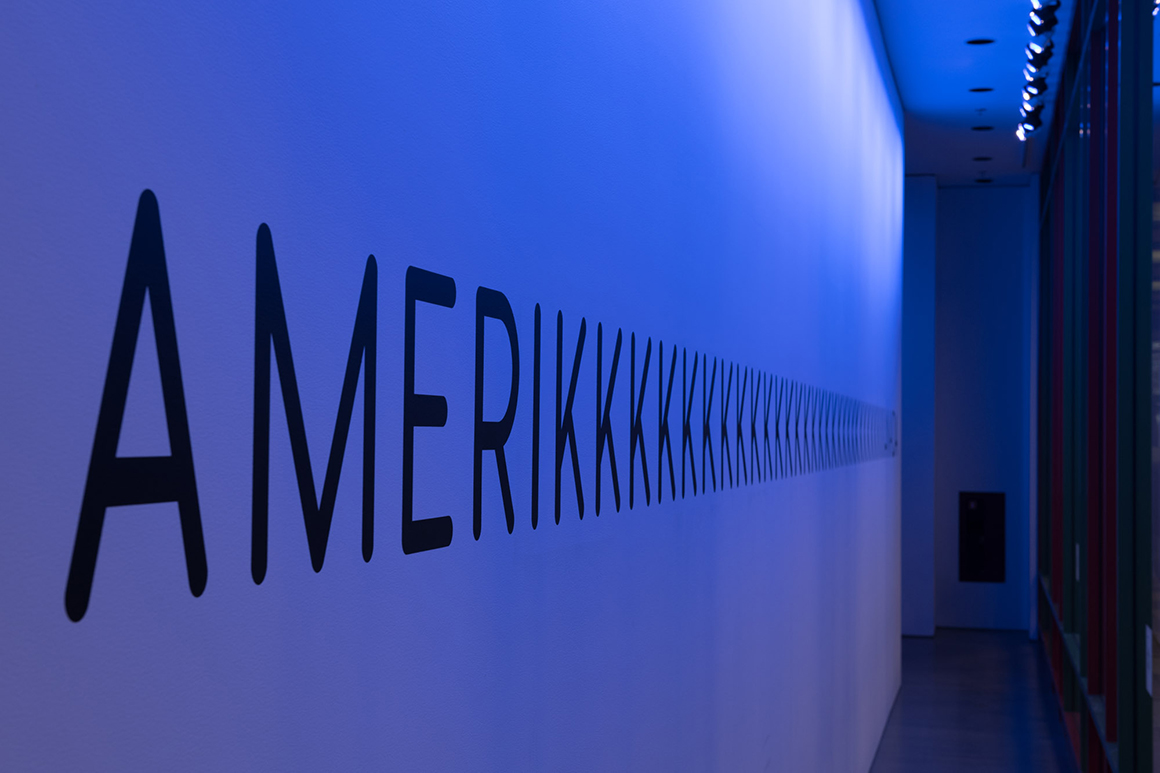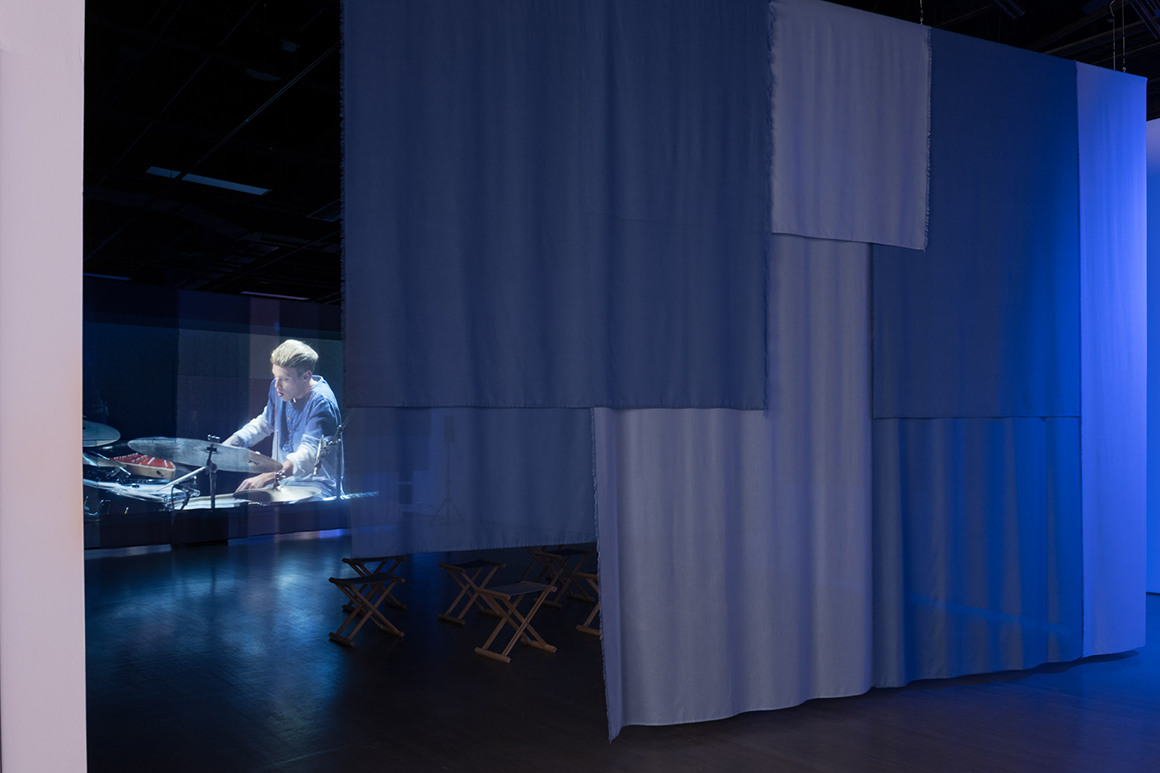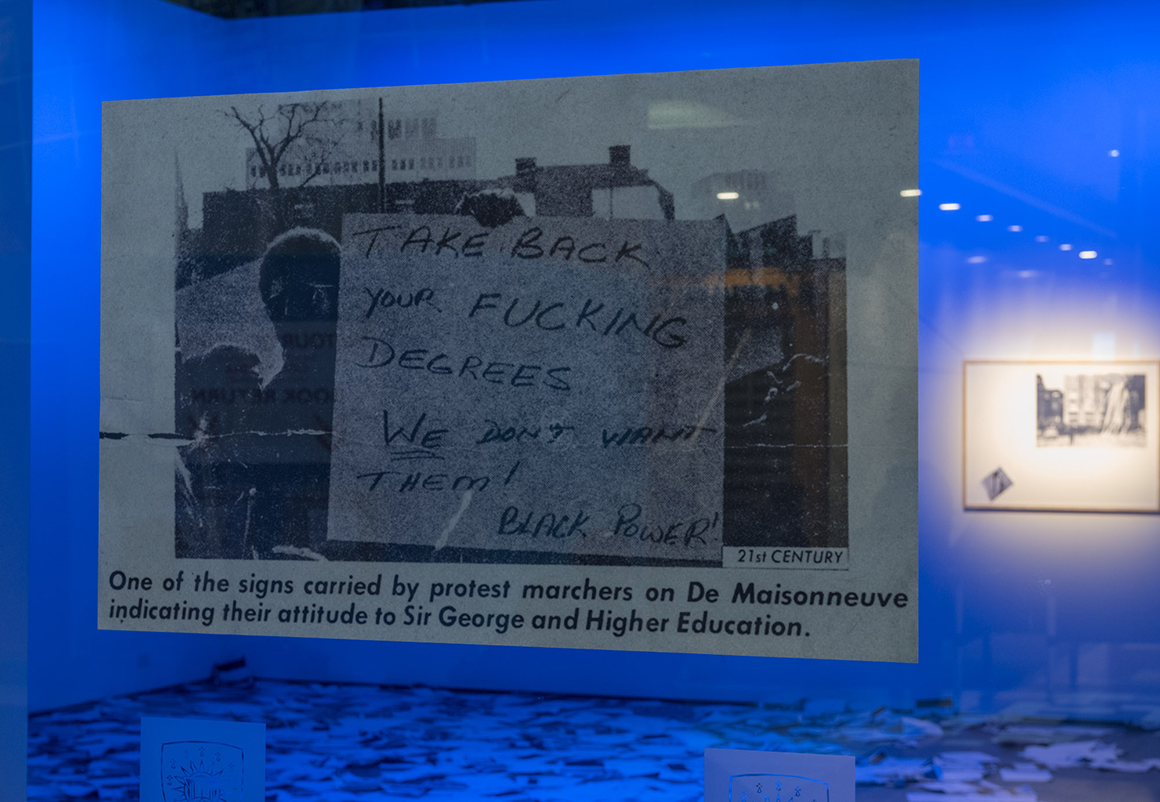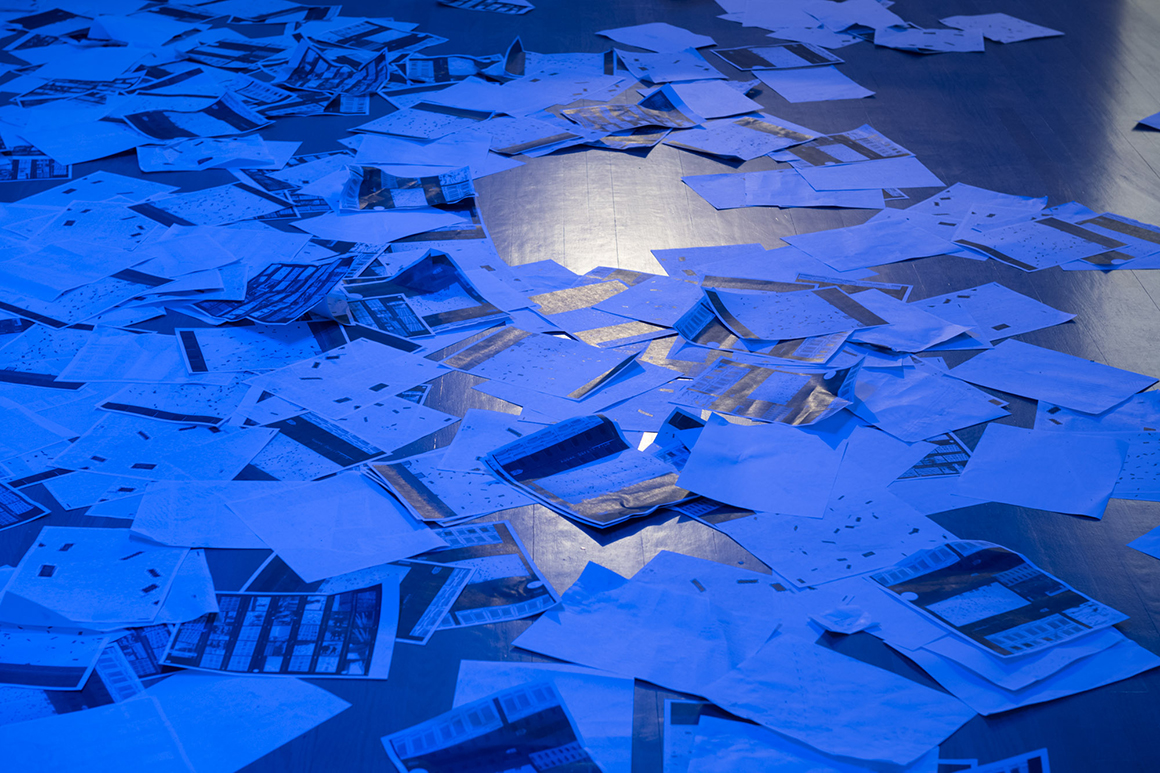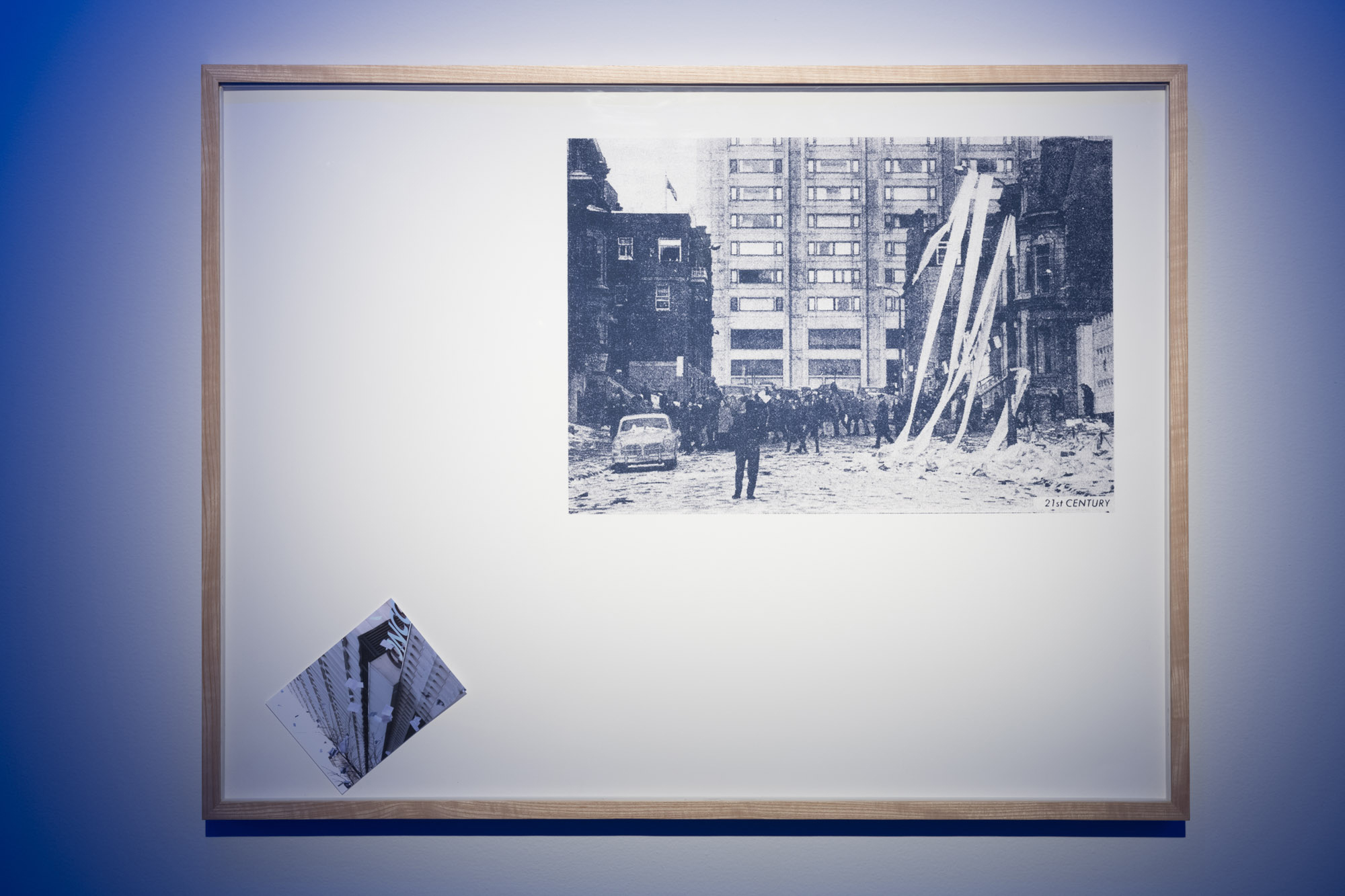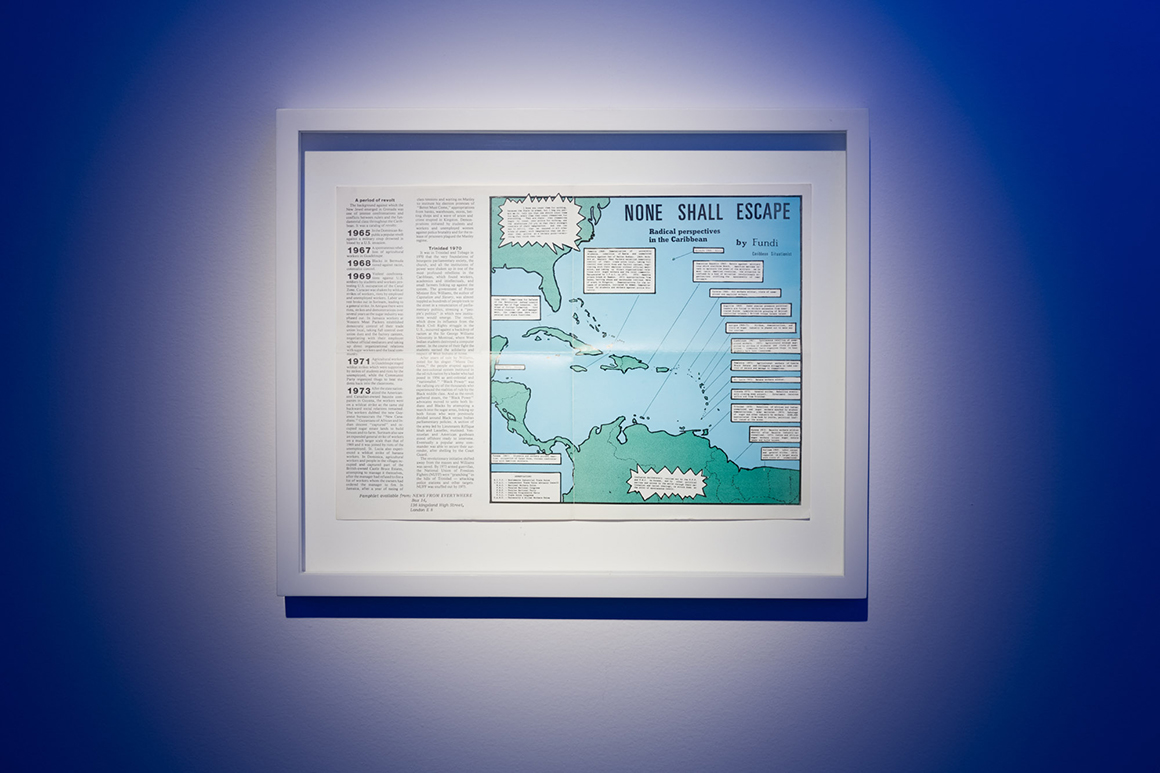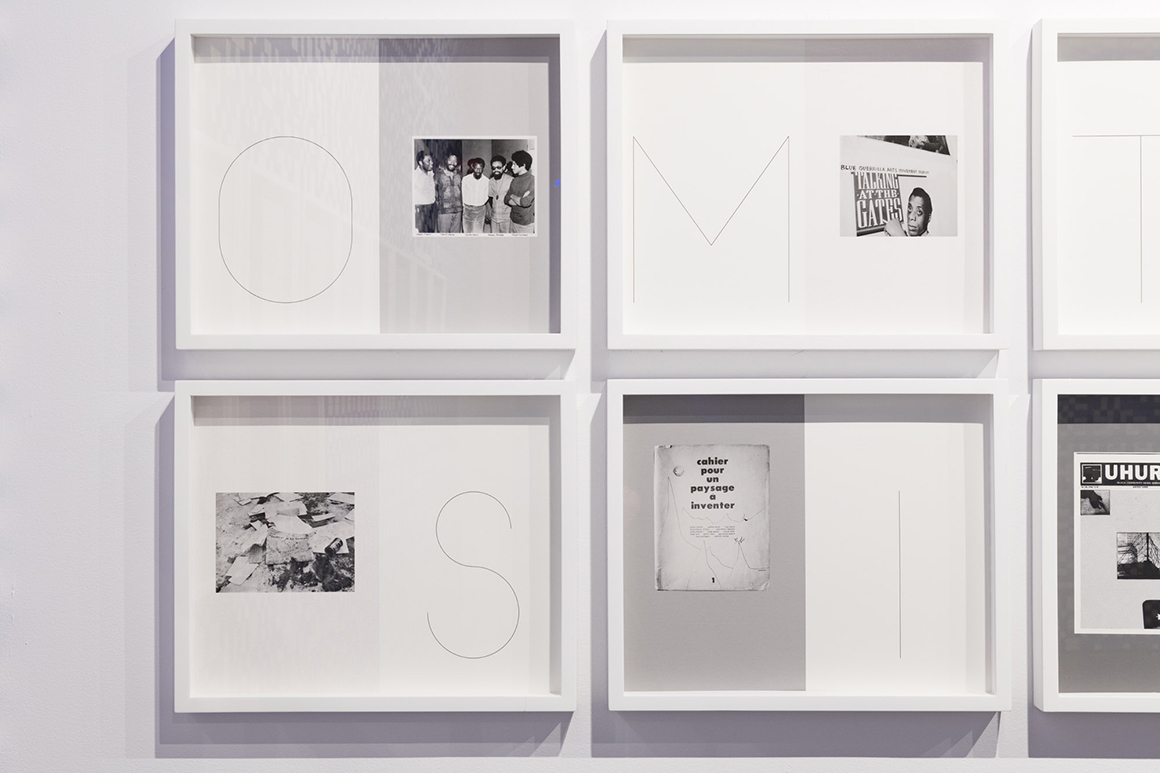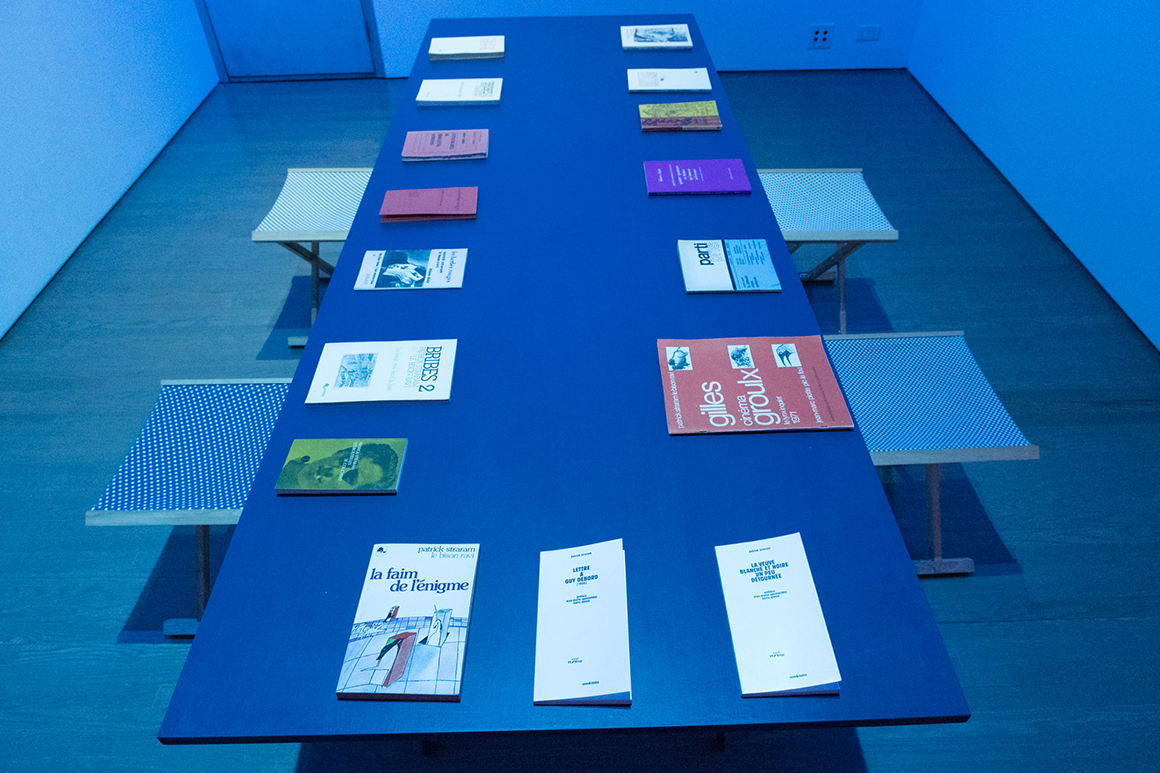Produced with the support of the Frederick and Mary Kay Lowy Art Education Fund.
A sprawling counter-archive, Blues Klair is assembled by Meessen in pursuit of the question: What is the colour of history? The result is a dense constellation of intersecting histories and documents. This web is anchored by three protagonists: poets Gylan Kain and Patrick Straram, and the students leading protests at Sir George Williams University (now Concordia), and is situated during the political and cultural ferment of the late-1960s and early-1970s. Never linear, Meessen’s history is guided by a sense for rebellion and critique throughout his references.
Below is a list of key concepts arising out of and guiding the research behind the exhibition. Each spur further questions, they can be applied in any combination or simultaneously to works on view, or adopted in dialogue with your own connections.
Read moreBLUE
Many blues can be found under the title Blues Klair. There’s Blues Clair a song by Django Reinhardt, a radio show hosted by Straram and an unrealized experimental novel. There’s Kain’s groundbreaking album Blue Guerilla and the blues tradition in music with its deep testimony of Black social life, singing and playing to pain, vulnerability and self-possession. There is the blue of the Atlantic and Indian Oceans that buoyed the slave trade and connected, among other things, the production and shipment of pigments. In Ultramarine, Kain comments on a nineteenth-century photo of a group of Bengali men working in an Indigo vat, an Englishman perched on its side: “He (referring to the Englishman) sees Prussian green, in the chemical journey to Indigo blue […]. I see fourteen Bengali men oxidizing.” In scrutinizing the Englishman’s and the camera’s perspective, Kain locates the image’s point of contradiction. Blue then is a tinted lens through which to see history for its discontinuity and illusions. These are contrasting blues.
EXILE
Is one placed or does one go into exile? Is it by law or refusal? Is exile understood, as it is at its root, as ruin, waste, and impoverishment? Or is it a measure of the poverty of the world as it is? Clear is that to be in exile is to live with an irrecoverable and painful loss; separated from one’s home, community, and family; in resignation to insecurity and movement.
Cultural critic Edward W. Said notes how contradiction follows the modern figure of the lone exile, émigré or expatriate, asking: What does the story of the disenfranchised individual add up to in face of mass, near anonymous, despair of today’s refugees? Amidst Said’s observations are two key points to adopt when considering Kain’s and Straram’s roles as exiles in Blues Klair. First, the idea that exile leads to a “scrupulous subjectivity,” a detailed and critical analysis of everyday life. And, second, keeping in mind Gyselinck’s drumming, exile as “contrapuntal,” offering alternative viewpoints, new rhythms and routes through contrasting elements. The punitive decrees, including imprisonment and deportation, borne by the Caribbean student protesters at Sir George Williams University, mark the use of exile as a weapon of the state and its various institutions.
K
A shifter is a word or element of language whose meaning is dependent on its context. Personal pronouns like “I” and “you” are shifters. They have provisional symbolic roles; they move around identifying a particular speaking subject, a location, or time.
Blues Klair nominates and is punctuated by an unusual shifter—k. K for Gylan Kain, K as the racist foundation of AmeriKKKa and KKKanada, K for Kébèk, K in Straram’s logorrhea answering his own question: Pourquoi s’appelle-t-il K.? (Why is he called K.?). In French, clair qualifies both a light hue as in bleu clair (light blue) and clarity, be it something physically transparent or an idea or statement formed with precision—crystalline. Unseating the c in clair, k then corrupts, cracks and connects the documents and histories found in the exhibition.
MOVING MEMORY
In Ultramarine we find moving memory somewhere between English and French, between “moving” as uttered by Kain and “(é)mouvante” as read in the subtitles. Moving spoken might be just this: a memory through breath, held in mind, in body, revived from documents, in circulation and restless. When read la mémoire émouvante is a memory that touches, one that is met with and made of emotion, simply put: a memory that moves.
Think about how words can be overlaid in voice and text, how this simultaneous, read contrapuntal, reception activates multiple points of emphasis. Think about the relationship between an image and its caption or its frame. Consider also the voice of the translator and artist: what is at stake in working in the parenthesis? Does it facilitate an accompaniment, in a near musical sense, to Kain and Gyselinck’s dialogue? Join Straram’s wanderings? Or stand witness to protest at Sir George Williams University?
SITUATION
Faced with the routines of everyday life under capitalism in post-war Europe, members of the Situationist International sought strategies to create “situations” that might return some autonomy to an otherwise over-determined and commodified life. Key among them was dérive: a reflexive approach to navigating the urban environment by keeping watch on unconscious cultural and environmental influences. Another strategy, détournement proposed appropriation, reuse, and interruption of past material as an affront to private property, a desanctification of value, and an avenue for new connections. Working with recuperated material opens up to play with recollection and the familiar. Accordingly, both aimed for a disorientation from which the repressive forces at play in the seemingly mundane might become sensible.
At various points in his practice Meessen has narrated minor histories of the Situationist International, in particular those outside of Western Europe. With Blues Klair we find Jamaican Situationist and labour activist George Myers, aka Joseph Edwards, aka Fundi, and Patrick Straram, never a member but who committed his life and work to a Situationist ethos. Viewed through this lens the actions at Sir George Williams University can be thought of as model “situations,” as concrete, interruptive and sensorial actions to which the Situationists might have looked.
SPECTER
What can be ascertained under the light of Blues Klair, through history’s blues as introduced above? How far does this blue spectrum, as spectra of colour and sound, reach? If spectography is the process by which an image is drawn from sound, can we think of Blues Klair as an apparatus for bringing into focus what is not seen but sensed?
Between references, across disparate histories, experiences, and locales a specter or specters might emerge. Presumed to have been left behind spectres of the unfinished, the overwritten, the disappeared, the catastrophic, the difficult to name all haunt and in their return trouble linear accounts of history.
For Meessen, the spectral is the seemingly past carried by the “post” of post-colonial and post-racial, it is equally present in the perverse novelty of neo-liberal. Like the furtive “k” in the entry above, the spectral addresses multiple and simultaneous times, locales and subjects. When in Ultramarine, Kain says “What eludes me,” is it heard as a question to an addressee: “What eludes me, my nigger?” Or is it a question he answers, an inventory in the making: “What eludes me: Indigo Blue”.
WEAVE, FRAME, STORYLINE
The French word “trame” is expansive, referring to textile construction, printing processes, literary, dramatic, and historical narration, to name a few of its uses. There is no equivalent in English with the same reach; “weave” is perhaps the closest approximation. In weaving, the “fil de trame” or weft is the thread that interlaces through the stationary warp threads. It is the weft that activates a textile’s pattern through minute intersections that bring a tension essential to holding the structure together. In printing “trame” or halftone is the distribution of dots, which through variations in gradation, orientation, and colour, come together as an image. In literature, trame is the plot. In theatre, trame refers to the Italian canovaccio, a rudimentary summary to guide an improvised performance.
Trame then appears and is accessed in Blues Klair both through tangible material—such as with the textiles—, reading documents both authored or presented by Meessen, and navigating the exhibition space. As the multiple definitions suggest trame is a case of correspondences, something found in the making, at times by chance, rather than in an array of discreet objects or stories.
CloseArtist
Vincent Meessen was born in Baltimore, USA, in 1971, and lives and works in Brussels (Belgium). He represented Belgium at the 56th Venice Biennale (2015) with Personne et les autres, a collective exhibition with ten artists from four continents. Solo exhibitions include Ultramarine, Printemps de Septembre, Toulouse (2018); Omar en Mai, Centre Georges Pompidou, Musée national d’art moderne, Paris (2018); Patterns for (Re)cognition in various iterations at BOZAR, Brussels (2017), Kunsthalle Basel (2015), and KIOSK, Ghent, 2013; Sire, je suis de l’ôtre pays, WIELS, Brussels (2016), and Mi ultima vida, An African Grammar After Roland Barthes, MUAC, Mexico City (2013-14).
Meessen has also participated in the group shows 50 Years after 50 Years of the Bauhaus 1968, Württembergischer Kunstverein Stuttgart (2018); and Gestures and Archives of the Present, Genealogies of the Future, Taipei Biennale (2016). His films have been shown in museums among which Kiasma (Helsinki), MUMOK (Vienna), Museo Reina Sofia (Madrid), Lincoln Center (New York) and in film festivals including IFFR (Rotterdam), IDFA (Amsterdam), Image Forum Festival (Tokyo), FESPACO (Ouagadougou). Vincent Meessen is founding member of Jubilee, platform for artistic research and production. Blues Klair is the artist’s first solo exhibition in Canada and the United States.
CloseWorks
K-Variable, 2018
Vinyl lettering in Belgika font.
Courtesy of the artist.
Amerikkkkk….kkkkanada is visible as an inscription outside the exhibition as a kind of preface to its experience. This portmanteau letter is a variable that can extend its size to adapt to its mural context; “politiKs” turns into “poetiKs” and vice-versa. A variable in the exhibition or the exhibition as variable. K as a mutable, shifting identity in the making. K for Kain, KTP, Amerika, Ku Klux Klan, Kanata, MoKum, Kandinsky, Kafka, Klossowski, Kiff, Kowass, Blues Klair, Monsieur K, Koderre.
CloseUltramarine, 2018
Video and textile installation with sound.
42 min. 46 sec.
Courtesy of the artist.
Disrupting the Eurocentric logic of historiography as well as that of museum classifications, Ultramarine sets a constellation of objects into motion, exposing their intertwined histories. The immersive experience of colour—a living, textured, spectral and polymorphic substance—is here rendered inseparable from its political component and from cinema as a magical practice. The film is conceived as a kind of “narrated exhibition” featuring Kain the Poet (KTP), the African-American poet and performer, part of the Black Arts Movement at the end of the 60s and creator of the mythic album Blue Guerilla. He colours history through spoken word, alluding to his own exile blues in Amsterdam while the drummer Lander Gyselinck improvises alongside.
Close21st Century, 2018
Digital inkjet print printed on blueback paper.
Courtesy of the artist.
Discordia, 2018
Digital inkjet prints on archival and photographic paper, flyers.
Courtesy of the artist.
The Black American militant playwright and poet LeRoi Jones/Amiri Baraka, author of Blues People: Negro Music in White America (1963), and one of the founders of the Black Arts Movement and the younger poet and performer Gylan Kain, each developed artistic responses to the struggles for civil recognition by Blacks in the mid to later 1960s by integrating in their work the life-affirming, politically engaging and uncompromising language of Black Power.
In 1968, six Caribbean students in Montreal, targets of discrimination at Sir George Williams University (today Concordia University), ignited an uprising and occupation that ended in violence. Emancipatory movements and discourse in the Caribbean and across the U.S. framed their demands and actions.
Images remain and circulate. An abstract landscape is drawn to occupy our imaginary, constructing a shifting, silent, partial memory of the event. Hundreds of computer cards and paper streaming from the ninth-floor windows of the university’s computer center, fluttering in the sky, wrapped around lampposts turned the street into a white landscape. A contrast to the wrecked interiors and jumbles of overturned chairs used as barricades. Police and people massing, standing, staring, waiting, passing, protesting. Remnants of a collective action and individual gestures engaged in a rewriting of the future.
CloseNew Canadians, 2018
Map of “None Shall Escape. Radical perspectives in the Caribbean by Fundi, Caribbean Situationist”, 1973, reprinted in 1984.
Courtesy of the artist.
In the aftermath of the computer center occupation at Sir George Williams University in 1969, and the arrest and long detainment of the Black participants, protests ensued in a number of Caribbean states from which many of the students came from. In 1973, Jamaican union activist Fundi (Joseph Edwards born Georges Myers) drew a map reporting on the various incidents of rebellion and their causes from the mid-60s to the early-70s.The Sir George Williams incident is mentioned as a moment of solidarity for West Indians. Canadian mining and banking interests were important in the English Caribbean, Guyana’s bauxite reserves in particular.
Fundi was a Situationist and his map was accompanied by a poster reproducing excerpts of Raoul Vaneigem’s section on “Radical Subjectivity” from his book The Revolution of Everyday Life (1967) as well as Guy Debord’s Thesis 90 from his chapter “The Proletariat as Subject and Representation” in his Society of the Spectacle (1967). Fundi forms a transnational constellation with Patrick Straram, exiled in Montreal since 1958 and an a pre-Situationist who in 1960 published Cahier pour un paysage inventé, in an attempt to introduce situationist practices in Québec.
ClosePostface, 2018
Digital inkjet prints on archival paper.
Courtesy of the artist.
Index, 2018
Twenty-six digital inkjet prints on archival paper.
Courtesy of the artist.
Postface is a theatrical ellipse in which three abstract characters Personne (no-one) et (and) les autres (the others) play out narratives with a constellation of images presented nearby in Index. This short play, specifically written for Blues Klair, refers to a text from 1960 by the Belgian critic André Frankin entitled “Préface à l’unité scénique ‘Personne et les autres’ ” published in the fifth issue of the International situationist; the typewritten manuscript was found by the artist in the archives of Patrick Straram in Montreal. The “Préface” was also the inspiration for Meessen’s project Personnes et les autres presented at the Venice Biennale in 2015. The catalogue of the exhibition was accompanied by a first “Postface to the Scenic Unit” in which the same three characters speculate on forgotten and hidden histories.
CloseStraram’s Trama, 2018
Drawing printed on vinyl.
Courtesy of the artist.
An undated drawing found in the archives of Patrick Straram realized during his youth and printed in blue, is the motif that occupies two large expanses of walls echoing the dense weave of the textiles surrounding Ultramarine. Its play of filled and empty squares, of openings and closures points to obstructions, absences and flow of passages. Trama as a surface for projective speculation against which the characters in Postface weave stories and correspondences echoed in Index’s series of images. Trama as a web of citations that generates new lines of flight towards the future.
CloseSans issue, 2018
Photograph printed on vinyl.
Courtesy of the artist.
Graffiti on a closed door noted by the artist on his daily walk to the Bibliothèque nationale to do research in the archives of Patrick Straram marks the haunting and continued presence of the triple K today in the West.
CloseProfiles
Gylan Kain, also known under his stage name, Kain the Poet, is a poet, playwright and actor born in Harlem (NYC) and living in Amsterdam. His spoken word practice, in dialogue with Beat culture as much as the rhetoric of Black Power, is among the precursors to hip-hop. He was one of the founding members of the Original Last Poets, created in New York in May 1968. He appeared with colleagues David Nelson and Felipe Luciano in Herbert Danska’s film Right On! (1970), in which they perform their contestatory poetics on the roofs of Harlem. That same year, Kain released his solo album Blue Guerilla on which he delivers incendiary lyrics over a background of free jazz. Through the Seventies, Kain was associated with the East Wind Cultural Center in Harlem and wrote for theatre, notably the plays Epitaph to a Coagulated Trinity and The Urination of Gylan Kain. At the beginning of the 1980s, he left the United States for Europe. There he collaborated with percussionist Z’ev and the group Electric Barbarians, among others. While long remaining in the shadows, Kain’s performances and phrasing, as well as the radicality of his words have influenced numerous numerous artists, notably the group The Prodigy who sampled his voice in their hit Voodoo People.
CloseBorn in 1987, the young Belgian jazz musician and composer, Gyselinck first came to hip-hop before making his mark in the experimental jazz scene. Not only is he a prodigious and inventive drummer, but also a composer with his various projects, including STUFF, a quintet mixing hip-hop, jazz and funk, the duo BeraadGeslagen, LABtrio and Ragini Trio, Sandy, the New York group Howard Peach, Sinister Sister, as well as his solo project, Known Alone. Gyselinck has received numerous prizes, notably three Music Industry Awards in 2015, 2016, and 2017, the Toots Thielemans Jazz Award (2010) and the Flemish Culture Prize for music (2015). He is a doctoral candidate at the Royal Conservatory and Academy of Fine Arts (KASK) in Ghent, where he also resides.
CloseIn April 1968, six Caribbean students—Kennedy Frederick, Allan Brown, Wendell K. Goodin, Douglas Mossop, Terrence Ballantyne, and Rodney James—laid charges with the Dean of Students at Sir George Williams University (now part of Concordia University) of discriminatory practices by biology professor Perry Anderson. With their complaint left unattended by the administration, the students’ frustration at this apparent dismissal turned into indignation. Protest ensued over the next year as they mobilized along with numerous white supporters, culminating in an occupation that ended in the destruction of the University’s computer centre. The event would become one of the most important incidents of racial conflict on a university campus in Canada, its repercussions extending to politics in the Caribbean.
Rallies by the students reflected the language of liberation and affirmation that accompanied the struggles for emancipation brewing over the past decades and resonated with American Black Power and Pan Africanism. Understood to have fueled the students’ determination was the Congress of Black Writers: Towards the Second Emancipation, the Dynamics of Black Liberation at McGill between October 11th and 14th 1968 and organized by Rosie Douglas (a prominent Dominican activist involved in the occupation at SGWU) and Elder Thebaud. Speakers included important Caribbean thinkers C.L.R James and Walter Rodney, as well as the charismatic Black Panther, Stokely Carmichael. This followed by the Hemispheric Conference to End the Vietnam War that took place in Montreal from November 29th to December 1st that same year, hosting representatives from the Black Panthers, the Vietnamese FLN, Cuba, Latin America, and Québec’s FLP, among others.
The University’s attempts to resolve the situation through internal memos, closed door meetings, and an endlessly recomposed committee—all judged biased by the students—only demonstrated how unprepared, confused, and, ultimately, unwilling the administration was to tackle systemic racism. Thirteen hundred students attended the first hearing on January 27th, 1969, but by that time relations between the complainants and the administration were deadlocked. At a second hearing held in the amphitheater of the Henry H.F. Hall Building on January 29th two hundred outraged students decided to occupy the computer center on the building’s ninth floor and eventually the faculty lounge on the seventh floor. They held their occupation peacefully for almost two weeks while negotiating with the administration through their lawyer. On the night of February 10th negotiations dramatically broke down. Riot police were called in, a fire broke out in the center, and the computers were destroyed. More than ninety students were arrested, among them forty Black students who were mostly Caribbean and in some cases non-residents of Canada. Some received prison sentences from a few months to a year and half; others were sent back to the Caribbean without finishing their degrees. After the occupation, the University proceeded with an enquiry concluding in Anderson’s favour. He continued to teach at the University through the 1970s. However, in the wake of the riot, the University did establish an ombudsman office and set up new procedures to address issues of inequality and discrimination.
Support for the Caribbean students during their battle with the administration came from students at SGWU as well as McGill, particularly from the universities’ respective Black students’ associations and student newspapers The Georgian and the McGill Daily. Following the arrests, a defense committee was formed to help with bail and the long judicial processes. The Union générale des étudiants du Québec among other Québec labour groups also offered their support. Montreal was in the throes of its own struggle for francophone emancipation and no stranger to such activity. Through 1968 a number of parallel mass protests erupted, notably a strike initiated by CEGEP students demanding access to higher education, the occupation of the École des beaux-arts where students held police at bay for weeks, and a sit-in by francophone McGill students denouncing discriminatory practices. However, the population at large in Montreal disapproved of the students’ actions at SGWU and the Black community was divided on the issue, critical of the violence, fearing backlash in their daily lives, and sensing a threat to the acceptance and integration painstakingly acquired.
The Computer Center Riot or the Sir George Williams Affair, as it has been called, remains surprisingly absent or downplayed in official Canadian accounts of emancipation. In the Anglophone Caribbean, notably Trinidad and Tobago, Jamaica, and Guyana, news of the riot and the fate of the arrested students led to demonstrations. The intensity of the occupation, the students’ profound commitment, and the violence they were met with was an uncomfortable reminder of the existence of racial inequality and the long history of Black oppression in a country that considered itself free of it. In Québec, the situation was complicated by francophone nationalism, which, in its more radical ethnic partiality, did not embrace, as it should, the growing plurality of its society.
ClosePatrick Straram was a French writer, poet, critic, jazz and film aficionado, and radio programmer. Leaving his family at fourteen for a makeshift existence in Paris’ bohemia, he developed a profound affinity for American jazz and the literary avant-garde and befriended many figures of the cultural milieu, among them Ivan Chtcheglov and Guy Debord, the latter who would be, in 1957, one of the founders of the Situationist International (SI). Never a member of the SI, Straram was nonetheless committed to its ethos, in particular a focus on daily life as a revolutionary means to liberate oneself from social and political alienation. Errantry characterized his entire life. In the mid-1950s he exiled himself from France, moving first to British Columbia in 1954, to Montreal in 1958, to California in 1968, and back to Montreal in 1970 where he continued his uncompromising life until his early death in 1988, ravaged and indigent.
Upon his arrival, Montreal was on the cusp of a cultural explosion linked to the modernization of Québec society and an opening up to liberatory leftist social and political movements that nourished and defined what is known as The Quiet Revolution. By the mid-60s, literature, film, and art in Montreal were undergoing an energetic redefinition in face of a rising middle-class consumerism that exacerbated a sense of alienation and threatened new forms of reification. Straram embraced the possibilities that such a society offered him. At the periphery of the center, as Montreal certainly was then, where new forms and processes had yet to coalesce, presented unprecedented potential for a figure that was both fascinated by the avant-garde and fiercely committed to living life at the threshold.
Within a year, Straram had joined the cultural scene and befriended a long list of poets, filmmakers and artists, closest to him was filmmaker Gilles Groulx, poet Gaston Miron, and Marxist political theorist Jean-Marc Piotte. He began writing for leftist and countercultural periodicals, among them Parti pris, Hobo-Québec, Stratégie, and Chroniques (which he co-founded), as well as the more popular TV Hebdo and MacLean’s. In 1960, he co-founded the Centre d’art de l’Élysée, the first film theater dedicated to new cinema, and later in 1974, the Centre d’essai Le Conventum a unique multidisciplinary center for the arts. At Radio-Canada he hosted programs presenting films, published writings, thinkers, filmmakers, actors and jazz music (Blues Clair aired from 1978 to 1979). He corresponded with French intellectuals, notably Debord, Jean-Luc Godard, Gilles Deleuze, Marguerite Duras, and the editors of Les Cahiers du cinéma.
Haunting the bars and taverns of the Quartier Latin, Straram was a very visible public figure in Montreal’s cultural life. His uncompromising Marxist and anarchist politics made him a contentious figure. Radically eschewing any dogmatism led him to turn his back on many of the periodicals and organizations from which he made a living. By 1968, faced with employment, he left Montreal for California. There he witnessed the Red Power Movement’s occupation of Alcatraz and the rise of Black Panthers militancy in the embattled figures of George Jackson and Angela Davis. In 1970, Straram returned with the pseudonym, le Bison ravi, adopted in solidarity with Indigenous struggles for land as witnessed in the United States. Assuming his role as a representative of the counterculture, Straram resumed his relentless critique of life by way of a critique that is life itself.
Straram published over a dozen books in a uniquely hybrid genre of collaged citations, enumerations, and first person repetitions that lead to a mix of poetic outpourings and political criticism. On radio, he delivered with the same density, commenting on the fly and weaving together private events and references to friends and thinkers fundamental to him. From 1980 on all of his writing appeared under the header Blues Clair. Inseparable from his way of life, Straram’s writing practice was utopic and, in many ways, revolutionary in its claim for an authenticity and freedom grounded in the individual’s daily existence. In this sense, he remained to the end bound to earlier and more artistic Situationist concepts of the construction of situations, dérive urbaine, and détournement, all actions which sought to create the conditions for the fulfillment of true and authentic desires by fusing the public and the private and returning to the individual control over his, her, or their own life.
CloseSupplementary Resources
Austin, David. Fear of a Black Nation: Race, Sex and Security in Sixties Montreal. Toronto: Between the Lines, 2013.
Davis, Angela Y. Blues Legacies and Black Feminism. New York: Pantheon Books, 1998.
Demos, T.J. Return to the Postcolony: Specters of Colonialism in Contemporary Art. Berlin: Sternberg Press, 2013.
Derrida, Jacques. Specters of Marx: The State of Debt, the Work of Mourning and the New International. Translated by Peggy Kamuf. New York: Routledge, 2006.
Eber, Dorothy. The Computer Centre Party: Canada meets Black Power. Montreal: Tundra Books, 1969.
Forsythe, Dennis, ed. Let the Niggers Burn! The Sir George Williams University Affair and its Caribbean Aftermath. Montreal : Black Rose Books, 1971.
Gilroy, Paul. The Black Atlantic: Modernity and Double Consciousness. New York: Verso, 2012.
Lewis, George E. “The Timeless Blues.” In Blues for Smoke, edited by Bennett Simpson, 76-91. Los Angeles: Museum of Contemporary Art, 2012.
Mills, Sean. The Empire Within: Postcolonial Thought and Political Activism in Sixties Montreal. Montreal : McGill-Queen’s University Press, 2010.
Myers, George (AKA Fundi). None Shall Escape: Radical Perspectives in the Caribbean. London: Caribbean Situationist, 1973. Excerpts and PDF here – https://libcom.org/library/radical-perspectives-carribean-fundi
Pastoureau, Michel. Blue: The History of a Color. Princeton, NJ : Princeton University Press, 2001.
Project Blues Clair : « Revisiter les pratiques d’écriture de Patrick Straram ». http://projetbluesclair.com/
Saïd, Edward W. Reflections on Exile and Other Essays. Cambridge, MA: Harvard University Press, 2000.
Santini, Sylvano. “La « bâtardise » de Patrick Straram. La gauche culturelle au Québec dans les années 1970 et ses suites.” Globe. Revue international d’études Québécoises. 14, no. 1 (2011): 53-75.
Taussig, Michael. What Color is the Sacred? Chicago : University of Chicago Press, 2009.
Warren, Jean-Philippe. “Le défi d’une histoire objective et inclusive. Fear of A Black Nation: Race, Sex and Security in Sixties Montreal par David Austin.”Bulletin d’histoire politique 23, no. 1 (2014): 264-291.
Vachon, Marc. L’arpenteur de la ville: l’utopie urbaine situationniste et Patrick Straram. Montreal: Triptyque, 2003
CloseGregos, Katerina and Vincent Meessen, eds. Personne et les autres. Milan: Mousse, 2015.
Meessen, Vincent, ed. The Third Form. Milan: Mousse, 2015.
– – – – –. The Other Country/L’autre pays. Berlin: Sternberg Press, 2018.
Tendu, Tshela and Vincent Meessen. Patterns for (Re)cognition. Brussels: BOZAR books, 2017.
Close“20,000 draughts sous les tables.” In Écrites de la taverne Royal, edited by Guy Haché, 109-139. Montreal: Les Éditions de l’Homme, 1962.
“Nationalité ? Domicile ?” Parti pris 2, no. 10-11 (June-July 1965): 52-79.
One + One : Cinémarx et Rolling Stones. Montreal: Les Herbes rouges, 1971.
With Jean-Marc Piotte. Gilles cinéma Groulx, le Lynx inquiet 1971. Montreal: Cinémathèque québécoise/Éditions québécoises, 1972.
Irish coffees au no name bar et vin rouge valley of the moon; graffiti/folk-rocks. Montreal: l’Hexagone/l’Obscène nyctalope, 1972.
4 x 4. Montreal: Les Herbes rouges, 1974.
Questionnement socra/cri/tique. Montreal: Éditions de l’Aurore, 1974.
La faim de l’énigme. Montreal: Éditions de l’Aurore, 1975.
With Jean-Marc Piotte and Madeline Gagnon. Portraits du voyage. Montreal: Éditions de l’Aurore, 1975.
Bribes 1: Pré-textes et lectures. Montreal: Éditions de l’Aurore, 1975.
Bribes 2: Le bison ravi fend la bise. Montreal: Éditions de l’Aurore, 1976.
Tea for one/no more tea. Montreal: Les Herbes rouges, 1983.
With Francine Simonin. Blues clair: Quatre quatuors en trains qu’amour advienne. Saint-Laurent, QC: Éditions de Noroît, 1984.
Les bouteilles se couchent. Paris : Allia, 2006.
Lettre à Guy Debord. Paris: Sens & Tonka, 2006.
La veuve blanche et noire un peu détournée. Paris: Sens & Tonka, 2006.
CloseVisit the Audio | Video section to access the audio-visual documentation of our public programs in conjunction with the exhibition.
Close






